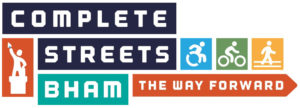An Interview with the City’s Transportation Director James Fowler
 Streets around the City of Birmingham are beginning to look and function differently. And it’s only the beginning of more changes to come, largely a result of the Bold Goals Coalition’s work to advance a major initiative called Complete Streets.
Streets around the City of Birmingham are beginning to look and function differently. And it’s only the beginning of more changes to come, largely a result of the Bold Goals Coalition’s work to advance a major initiative called Complete Streets.
Last year, the Birmingham City Council unanimously approved a Complete Streets policy, setting a new direction in designing streets to emphasize safety and accessibility for everyone, including walkers, cyclists, transit riders and those in wheelchairs, as well as drivers. More than 20 organizations worked with city staff to develop the policy, provide training and technical assistance and build support throughout the community through the Complete Streets Birmingham campaign.
 Since the policy’s approval, the city has embraced this new vision and rebranded its Department of Traffic Engineering to become the Department of Transportation, reflecting a commitment to design streets to accommodate all people, regardless of their abilities or how they travel.
Since the policy’s approval, the city has embraced this new vision and rebranded its Department of Traffic Engineering to become the Department of Transportation, reflecting a commitment to design streets to accommodate all people, regardless of their abilities or how they travel.
Following are a few questions that James Fowler, Director of the City of Birmingham’s Department of Transportation, recently answered concerning Complete Streets and how smarter road design can help shape Birmingham’s future.
How has the city’s Complete Streets policy changed the way the Birmingham approaches transportation projects?
JF: The policy has primarily given city staff the justification needed to change the design of city streets. Every design decision affects users differently, so having a general policy that provides guidance is very helpful. For example, if we remove a vehicular travel lane in order to create a bicycle lane or a dedicated bus lane, that choice will increase access for some users (cyclists or transit riders) while reducing access for others (general vehicular drivers). We try to only reallocate space where extra lanes exist, but even still, the policy guidance is helpful in justifying that trade-off.
What are some recent street projects that have included Complete Streets features?
 JF: We’ve so far been incorporating Complete Streets elements into projects that are already underway, such as general resurfacing projects. When a roadway is resurfaced, that’s the best opportunity to change the striping configuration. Some roadways where this has already occurred, or are about to occur, are Ensley Avenue, Messer Airport Highway and Center Street. These roadways have been redesigned to include access for cyclists. Similarly, UAB has recently completed a redesign of 10th Avenue South. This roadway now includes bike lanes and it also includes significantly enhanced intersection crossings for pedestrians.
JF: We’ve so far been incorporating Complete Streets elements into projects that are already underway, such as general resurfacing projects. When a roadway is resurfaced, that’s the best opportunity to change the striping configuration. Some roadways where this has already occurred, or are about to occur, are Ensley Avenue, Messer Airport Highway and Center Street. These roadways have been redesigned to include access for cyclists. Similarly, UAB has recently completed a redesign of 10th Avenue South. This roadway now includes bike lanes and it also includes significantly enhanced intersection crossings for pedestrians.
What are some projects that will include Complete Streets designs in the future?
JF: The biggest project that’s coming in the future will be the bus rapid transit project – the Birmingham Xpress. This project will include significant sections of dedicated bus lanes together with enhanced bus stops, which will be elevated platforms, as well as significant expansions of sidewalks. There is also a major streetscape project planned through downtown Avondale along 41st Street. That project will include enhanced landscaping, lighting, sidewalks and bike lanes.
How does Complete Streets support the city’s plans for future growth and development?
JF: Birmingham has an opportunity to grow differently going forward, and the Complete Streets Policy directly supports that. Other major cities that have seen significant growth in previous decades have quickly become overwhelmed by vehicular congestion. Since we are seeing strong growth trends in our own city, it will be very important for us to choose a different path now. We’ll need to continue to invest in better infrastructure for pedestrians, transit riders and cyclists. Ultimately, we’ll need to provide safe and convenient options. A Complete Streets approach is the way to achieve that.
Stay in touch with the Bold Goals Coalition on Facebook for updates on collaborative projects such as this throughout the region.
The Bold Goals Coalition is 200 organizations solving big community problems by aligning partners, resources and agencies.

